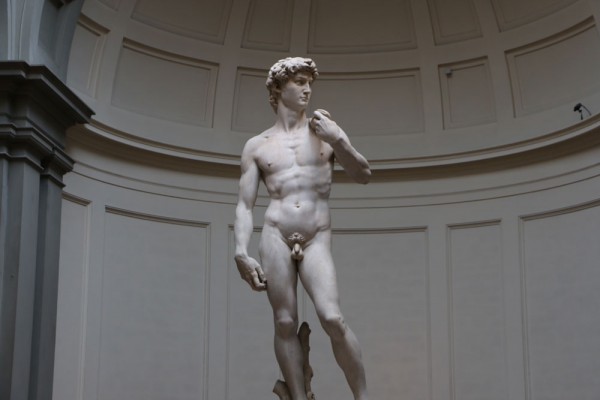Michelangelo’s David at the Accademia
 On July 1501, Michelangelo Buonarroti received the commission by the Opera del Duomo to create a statue that featured David and Goliath, and to use the large piece of marble block that was lying unused within the Cathedral’s workshop. This piece of marble was already partially worked and cut by the sculptor Agostino di Duccio, who had received the same commission and tried his hand about 40 years earlier. This presented a true challenge to Michelangelo, who was 26 years old at the time and had just returned from Rome after creating his first masterpiece, the Pietà, today conserved within the Basilica of St. Peter’s at the Vatican.
On July 1501, Michelangelo Buonarroti received the commission by the Opera del Duomo to create a statue that featured David and Goliath, and to use the large piece of marble block that was lying unused within the Cathedral’s workshop. This piece of marble was already partially worked and cut by the sculptor Agostino di Duccio, who had received the same commission and tried his hand about 40 years earlier. This presented a true challenge to Michelangelo, who was 26 years old at the time and had just returned from Rome after creating his first masterpiece, the Pietà, today conserved within the Basilica of St. Peter’s at the Vatican.
The commission, at the start a religious commission destined to be placed atop one of the spurs of Florence’s cathedral, was taken over by the Government of the Republic of Florence once it was decided that the figure of David could well symbolize the virtue of good government and defense of the homeland. These are the years when the Medici had been exiled from Florence and in which Niccolò Machiavelli was secretary to the second Chancellor’s Office of the Republic (what today we call the Ministry of Foreign Affairs).
After having prepared the work with many designs and small wax models, Michelangelo started work on the marble block in in 1502. He worked on his own, standing on wood scaffolding that surrounded the large block. By January 1504 the statue was finished and was judged by all as magnificent and extraordinary! It was decided that a commission, in which Leonardo da Vinci was a part of, was necessary to decide where exactly to place it.
It was thus decided by Florentines that Michelangelo’s David was to be placed in front of Palazzo della Signoria, where it was placed on September 8, 1504 and where it remained until July 1873.
David and Goliath
 The subject is from the Bible and had already been represented by various great Florentine sculptors of the Renaissance, including Donatello, Ghiberti and Verrocchio, who had all portrayed David as a young adolescent and after he had already cut off the giant Goliath’s head. Michelangelo instead chose to represent David as a young man, since the Bible says he was already 16 years old, and in a moment where he is holding a rock in his hand, with the sling on his shoulder as he prepares to fight the giant. The tension of hte young man as he prepares to face off the terrible enemy, one no one had dared to challenge before, is represented by Michelangelo with beautiful details: an intense look in the eyes, contracted muscles which make it seem as if David is holding his breath, and veins standing out which make it seem as if blood is truly flowing through the marble.
The subject is from the Bible and had already been represented by various great Florentine sculptors of the Renaissance, including Donatello, Ghiberti and Verrocchio, who had all portrayed David as a young adolescent and after he had already cut off the giant Goliath’s head. Michelangelo instead chose to represent David as a young man, since the Bible says he was already 16 years old, and in a moment where he is holding a rock in his hand, with the sling on his shoulder as he prepares to fight the giant. The tension of hte young man as he prepares to face off the terrible enemy, one no one had dared to challenge before, is represented by Michelangelo with beautiful details: an intense look in the eyes, contracted muscles which make it seem as if David is holding his breath, and veins standing out which make it seem as if blood is truly flowing through the marble.
The positioning of the statue in Piazza della Signoria certainly emphasized the political significance of the character rather than the religious, and in that place David came to represent the symbol of Florentine freedom against its powerful enemies of the time. Standing in front of the city’s government building, the statue of David represented the courage and virtues of Florence much like a statue of a Greek hero given its nudity and classic “contrapposto” pose, with both right leg and arm straight while the left ones were bent, giving the figure life and movement. Michelangelo’s David in fact represented the rebirth of ancient beauty, but with a completely contemporary significance.

According to accounts by his contemporaries, Michelangelo just took 18 months to create one of the great statues in the world, working on his own without aid and hidden behind a wooden cage so that no one could see the statue before it was complete. He was paid well, 400 ducats, but above all, with this masterpiece he became famous across Italy and even in many European courts and remains today one of our times most famous artists of all time.
For music lovers, the Accademia Gallery offers a surprise within the Luigi Cherubini Music Conservatory.











